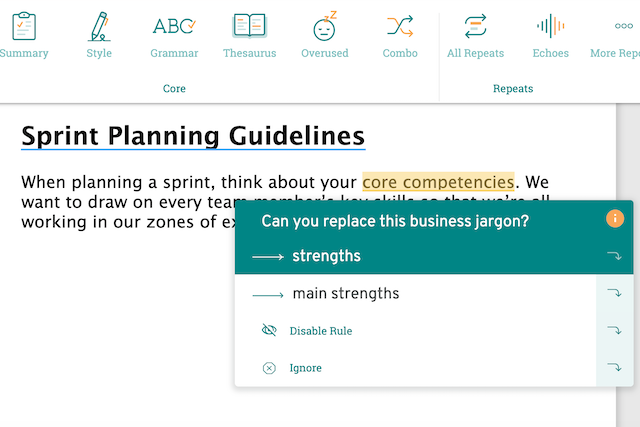
Set Your Leadership Language
Before a leader writes articles, white papers, emails, and internal communications, they need to establish a language that resonates throughout the business and communicates across all channels.
Leadership empowers team members to be better human beings in a process that instils accountability and creates a common leadership language. If you’ve just been promoted to a leadership position managing other people, this article will help you establish the baseline for how your group communicates.
If you used to sell widgets and now manage a team of widget sellers, or you were the superstar data plumber and now manage a team, or you were the CFO and now the President, here are some tips for setting up the culture and language of your group to communicate effectively and set expectations.
Emotional Awareness
Language expresses your belief system and reflects what you do. As I tell my fiction writing students, dialogue is action. What you say represents the culture you build in your group or organization. Your language sets the emotional tone for the group.
You, as the leader, are responsible for the group’s success. Assuming a leadership role requires knowing your emotional strengths and weaknesses. You need to know, because as you set guidelines and responsibilities, you may meet resistance. Every group has the one person who tries to skirt the edges and make exceptions. How you tackle responses is part of your leadership.
The culture you create for your team starts with who you are.
Format Your Culture
You create the culture by the things you do. That’s not what you say you do or what you say others should do, but what you actually do. You are the role model, the exemplar for the people you lead. Act the way you want your group to act. It’s your strongest culture message.
Errol Doebler, of Leader 193, wrote in his book The Process, Art, and Science of Leadership: How Leaders Inspire Confidence and Clarity in Combat, in the Boardroom, and at the Kitchen Table
...leaders should focus on creating an environment people love, and an environment people love is one that is predictable.
Predictable is the opposite of willy-nilly. Thought and planning while paring down to essentials will help you formulate a culture of predictability that reassures your group. Identify your group’s major goals and then formulate your guidelines, so the team understands not just the goals, but the reason for the method underlying your guidelines.
Group Guidelines
Guidelines are straightforward recommendations that set the tone of your group environment to facilitate reaching group goals. Start with one or two. You are setting your expectations for the group.
If you are a new leader or your group is new, begin with expectations you can meet to set an example. Be prepared for pushback. You can set a simple guideline like “be on time.” When you first introduce the concept, you’ll get general agreement. It’s simple. It’s reasonable.
Then, when you set a meeting time and start the meeting on time, latecomers may feel resentful. They may ask for leeway. You’ll hear questions like “Why don’t you wait a few minutes so everyone can join?” Everyone, of course, is the latecomer.
Reiterate to the entire group how timeliness facilitates effective action. In this case, timeliness facilitates the meeting for everyone. You can address meeting agenda items, and then the entire group can return to what they were doing at work. Keep your remarks positive. You don’t need to mention how that latecomer is holding up the entire group. Save those comments for repeat latecomers in a private meeting.
After a few meetings that start (and end) on time, you will set expectations for the group.

Know Where You Are
The business world is filled with buzzwords like mission and purpose, but you need to know what the current situation is to determine what actions to take. As a leader, you outline the situation and how the circumstances require action.
As work trickles down to team members and workers, they need to know why they are doing something. How does their action contribute to the purpose of the group? Without an overview, people feel they are working randomly—because you said so—rather than contributing to the overall purpose.
Clarify the set of circumstances that require a need for action.
Set the Goal
Define the goal that arises from your purpose. Everyone on the team needs to know what needs to be accomplished and what the purpose of the action is. To help all team members understand, clearly define what the team needs to accomplish.
If you set several goals, make it clear that each goal is separate. Refrain from trying to bunch them together under one goal: the big goal. Break each goal out individually so they are clear.
Define the Actions
Actions are the steps that need to be accomplished to complete the goal. New leaders may be unaccustomed to setting actions for others. But defining the actions that lead to accomplishing the goal clarifies roles. You support your team members with clear steps to take in their role on the team.
Along with clear action steps, identify when those actions are to be completed. You establish an effective plan to reach the targeted goal.

Designate Accountability
Assign people on your team to be responsible and accountable for completing specific actions for the team’s purpose. Free yourself from hoping and assuming that an action will get done. Make clear who is in charge of getting each action accomplished.
Your leadership role is the act of assigning who is in charge of what. The clearer you are with accountability, the easier it is for each team member to understand their role and what specific actions they need to take.
Facilitate timely completion by setting up a check-in system as a completion date nears. Some leaders assign one person to check in on upcoming dates. They remind the individual assigned to the task about the completion date. You’ll help procrastinators stay on track and on time.
Communication
As the leader, you must communicate in a consistent, methodical, and precise manner. You are responsible for communicating up, down, and across the chain of command.
Having a communication plan is not about soft skills like tone of voice, delivery, and body language. It’s about deciding:
- who you will talk to
- when you will talk with them
- the mode of communication (phone, in person, video conference)
- the length of the conversation
- the topic of the conversation
You will share progress with your boss and the status of your goal with those on your team. You’ll also need to share updates with other leaders in the business that will be affected by your team’s actions. Have a communication plan for each conversation.
Common Language
Each industry has its own terminology. Sometimes the terminology can shift depending on team member geographic location. As the leader, you set the standard terminology for your group. For example, decide if you will use goal or mission, and then use that term consistently.
Set the example of using language for clear and precise communication. If you have people in diverse locations, like India, Germany, and Malaysia, clear terminology helps them communicate using the same terminology to eliminate confusion.
When choosing the terms you will use with your team, don’t just stick to buzzwords you’ve used in the past. Think about which word will communicate your meaning most effectively. Most of the time, this means side-stepping overused business jargon and opting for something more definitive.
While drawing your documentation together, watch out for ProWritingAid’s business jargon suggestions. These will highlight any stale jargon, and prompt you to re-think your word choice.

With ProWritingAid’s business settings, you can make sure that your language is clear, efficient, and effective.
Not a ProWritingAid user yet?
Good Leadership Sets Clear Language Channels
When you are clear about your leadership role, establishing your team’s purpose, actions, accountability, and communication, you facilitate agreement among team members on all aspects of your team’s role.
As a leader, you set the standards for how and when you communicate with your team. And you create the guidelines for how team members communicate with each other.
Clear direction helps people understand their role in the team and the actions they must take to contribute to the team’s overall success. You lead by setting an example of clear language, accountability, and channels for reporting.
ProWritingAid will guide you to writing clear and effective language that transmits your leadership principles. You can even use it across your team to help keep language consistent and ensure polished writing, every time.


